
The end of the silent era brought a notable amount of changes at the Fleischer’s studios. The Out of the Inkwell series was closed, and KoKo temporarely retired. Instead, a new series took its place, the Talkartoons, started as a series of one-shots, but later transformed into a vehicle to promote the studio’s new stars, the first of which was Bimbo.

Evolved from an earlier prototype (Fitz, the dog from the KoKo shorts), Bimbo starred in some of the most celebrated short cartoons from the Fleischers. Ironically, Bimbo himself is not a very interesting character. At the time, Mickey Mouse was the biggest star in animated films, and many clones of him started to appear shortly thereafter. Bimbo is slightly different design-wise (eyes and mouth are a bit different) but his personality overall doesn’t really stand out. He acts more like an average person, who can be put in almost every surreal situation and react accordingly – in this sense he’s very similar to the future Porky Pig and, again, Mickey Mouse.
The style of the Fleischer cartoons (and of East Coast cartoons in general) was very different from what was being produced on the West Coast (which at the time included Disney and his imitators). The Fleischers were still deeply rooted inot the early days of animation: anything can happen in a cartoon, and that’s exactly what happens: everything. Many of the Talkartoons don’t have a tight narrative structure; they’re instead more of a “stream of consciousnes”, where ideas and visuals are only vaguely related together. The purpose was also completely different: while Disney and his animators were trying to achieve some sort of “realism”, by creating believable animation that could compete with live-action actors, the Fleischers didn’t seem to care as much; their characters (at least in the early days) are not truly “acting”, but they instead seem to move just for the sake of fun. Every movement is rigid and calculated: it looks more like dancing than actual acting, and it’s even synchronized with the music. The designs are also very different in what they’re trying to achieve: while Disney (and his imitators) is trying to achieve some sort of “perfect beauty” with his cartoons (making all of the characters as appealing and pleasing as possible), the Fleischers were more interested in creating funny drawings, and it’s possible to see more variety among their characters because of this. Their differences even came down to the kind of music they used: if Disney used mostly classical pieces and original compositions, the Fleischers used a lot of modern jazz music. And of course, there’s the kind of humor involved, often raunchy and surreal in the Fleischer cartoons, and grounded in reality and character-based in Disney.
Of course, the animation style was highly influenced by the animators. The most influential out of all of them was probably Grim Natwick, one of the greatest animators who have ever lived. He would probably deserve an article of his own. He worked in almost every major studio in Hollywood and experimented with a wide variety of styles, ranging from the cartoony Fleischer shorts, to the more realistic Disney films, and the limited animation used in the UPA cartoons. He had a great hand in developing the early Fleischer style (the so-called “rubber-hose” style of animation) and he continued to work for them until 1931. After his departure, his style would be gradually abandoned and the Fleischers would start to take some lessons from the Disney style (both in a positive and negative sense).
One of the most representative and famous shorts from the earlier Talkartoons is probably Swing You Sinners! (1930), directed by Ted Sears, in which Bimbo steals a chicken and must pay his crime in what is essentially a vision from Hell. The short contains all characteristics usually associated with the Fleischer style: the short doesn’t have a solid narrative structure, and is even awkwardly directed at some points (there are some weird jump-cuts near the beginning), but it contains some of the most creative and surreal imagery ever put on screen at the time. The animation is crude and imperfect, but it’s synchronized almost perfectly with the music, with the characters dancing and moving to the beat. None of these earlier shorts are among the best work produced by the Fleischers, but they better represent their overall style, which would become even more refined and sophisticated in the following years.
An important thing to note is that Dave Fleischer didn’t actually direct most of the shorts, despite what the credits say. Despite him being a general supervisor, the director was usually the first credited animator (who didn’t actually animate). There aren’t a lot of differences between directors, though: one of the more active ones was Willard Bowsky (who unfortunately died during World War II), who is responsable for some of the creepiest shorts of the Fleischer library (on top of being a great animator himself).
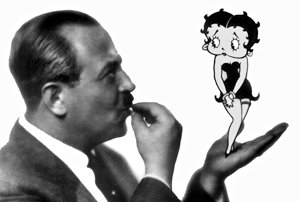
The biggest legacy of Grim Natwick will probably remain the creation of Betty Boop, which would go on to become one of Fleischer’s biggest stars. Betty Boop stands out almost immediately starting from his appearence, thanks in part to her design (she was designed by Natwick himself), very different from many of the characters that were populating Hollywood at the time (most of the female characters were simply variations of their male counterparts, with a few different features, while Betty actually had a variety of shapes). The design of Betty Boop went through a lot of variations in just a few years, before reaching the “definitive” one, in 1933. Bimbo and Betty co-starred together in many notable shorts, but we’re going to take a look only at some of the most popular ones.
Bimbo’s Initiation (1931)

Probably the most famous Bimbo cartoon, and often quoted as one of the creepiest ones due to his subtext, although it’s actually pretty tame compared to other shorts from the Fleischers. It’s about Bimbo running away from a secret cult that wants him to join them (“Wanna be a member?”).
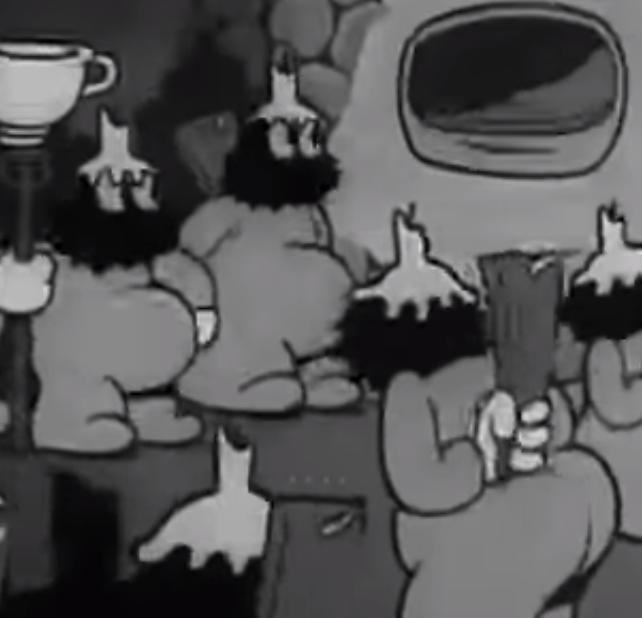
The short actually being before the title card: the members of the society sing a little song. This will be recurrent through the short: the members will only spoke through singing.
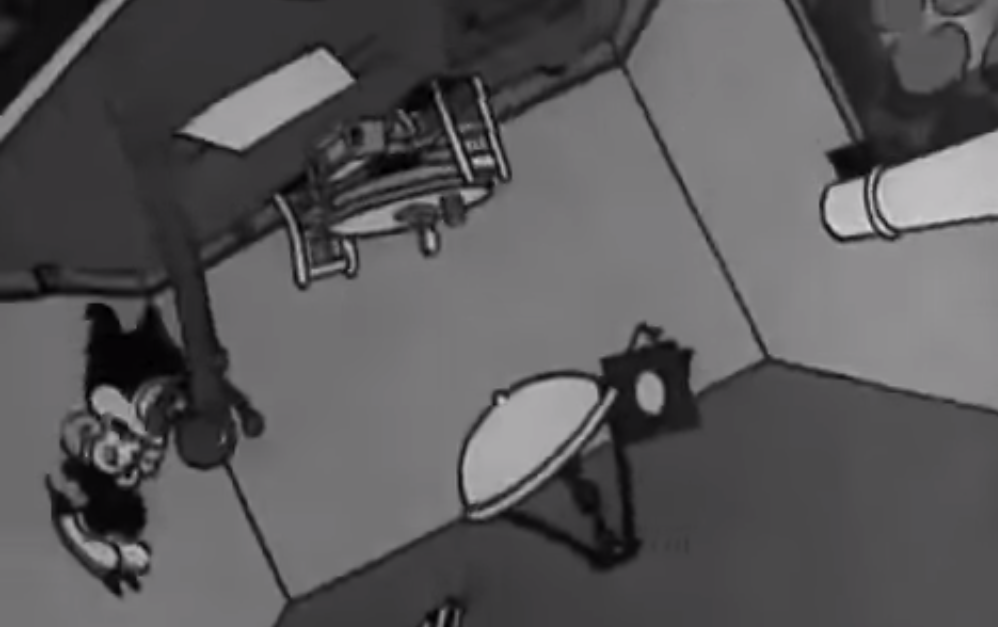
The short doesn’t waste time and we get the first of many complicated, with the room turning upside down. This cartoon looks like it was made to experiment several complicated sequences.
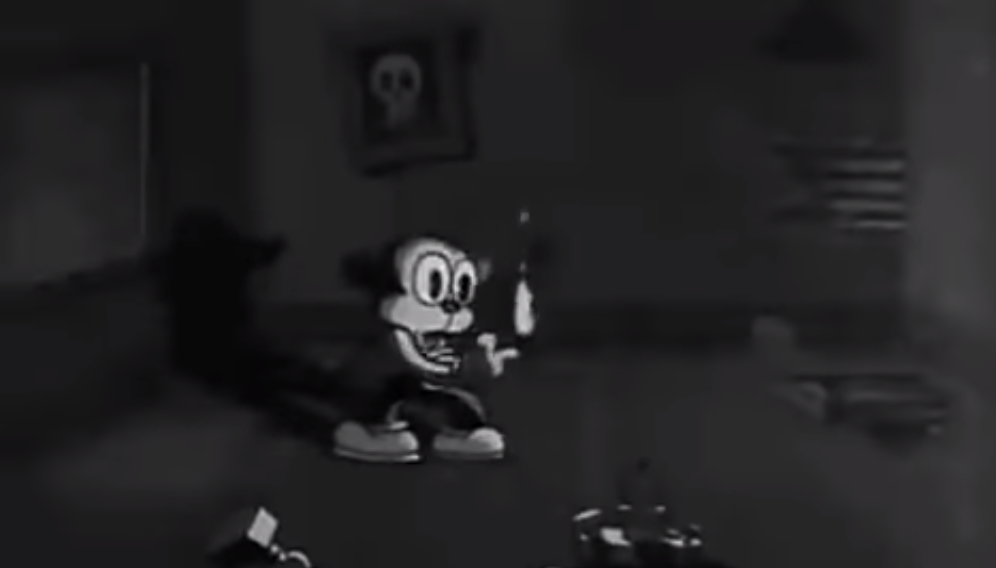
Then there’s a series of beautiful shots in black and white, with great variations of grey. The whole sequence with the candle in general is just great: there’s even an attempt at pulling off a long shot (not particularly complicated, but it’s ambitious for the time).
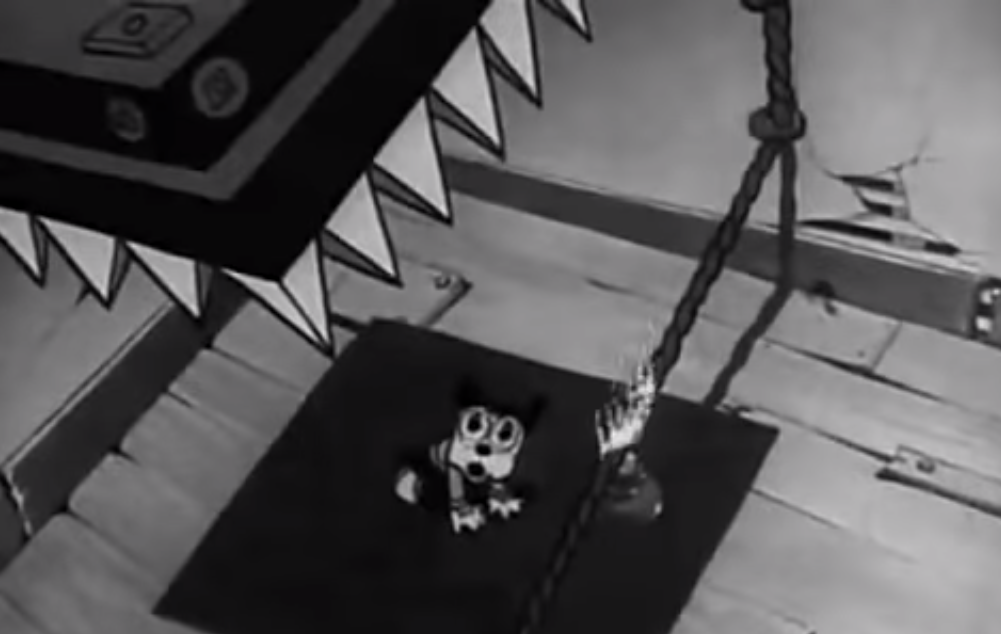
And of course, there are also some great, distorted angles.
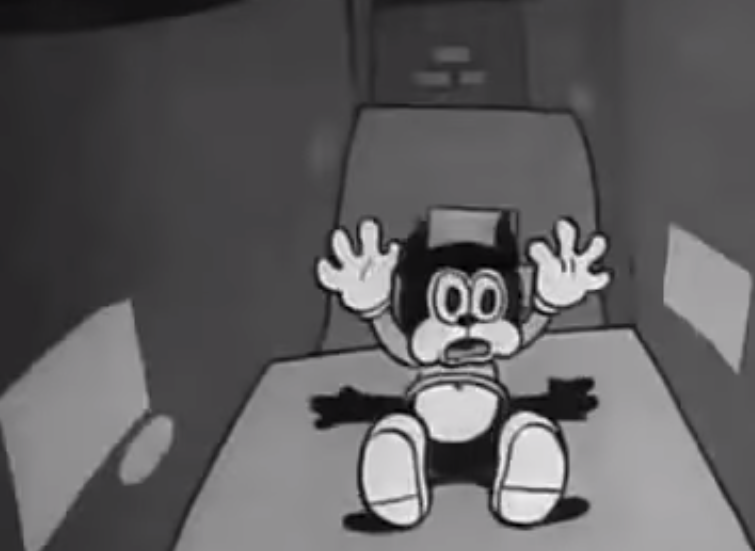
Later, there’s easily the best sequence of the entire cartoon: it’s a tracking shot, that lasts for almost an entire minute, and use of perspective. It’s MOVING perspective, something that not even Disney animators could accomplish yet. To do this, without any cutting, is truly remarkable. And of course, while all of this is happening, Bimbo is running in tune with the music.
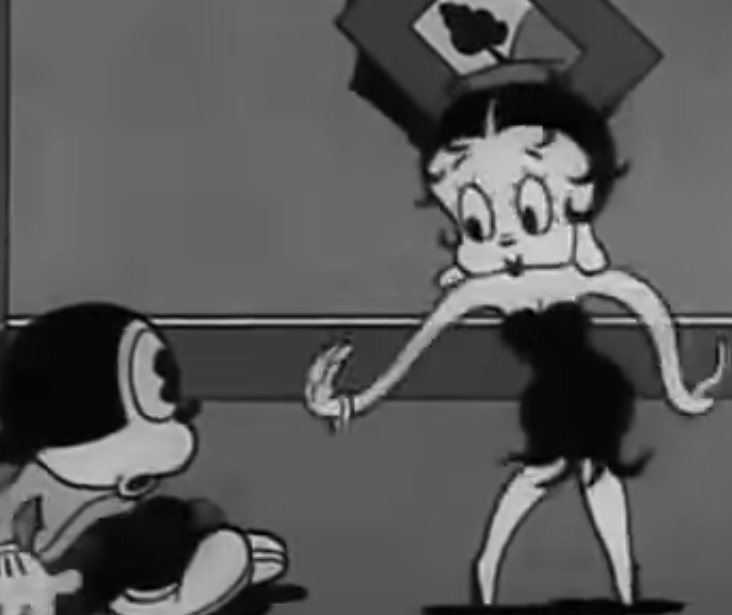
And of course, there’s Betty Boop and her little “dance”, to show off some unrealistic (but fun to watch) movement. Easily one of the best Talkartoons due to his technical complexity, but the best has yet to come.
Minnie the Moocher (1932)

This is the first in a trilogy of shorts featuring Cab Calloway, who even makes an appearence in the beginning. These are some of the most celebrated shorts of the 1930s, and for good reasons. Minnie the Moocher is no exception. It’s directed by Willard Bowsky.

One of the main characteristics of the Fleischers is the great amount of gags present in each shot. In the beginning, for example, Betty’s father repeatedly punches the table and the objects constantely switch position.
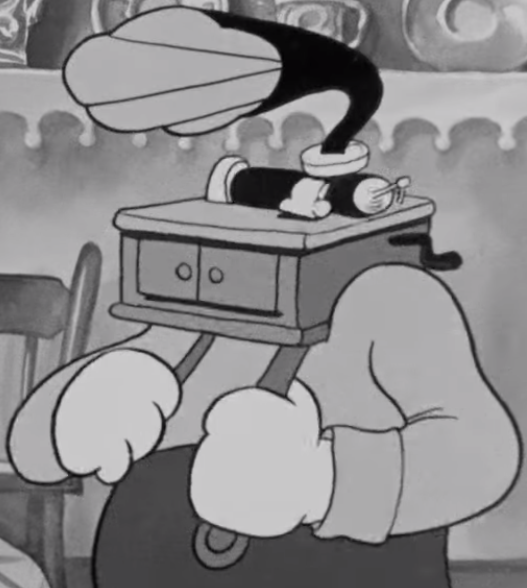
Other trademarks are inanimated objects coming to life, and people morphing into objects (such as the father’s head).
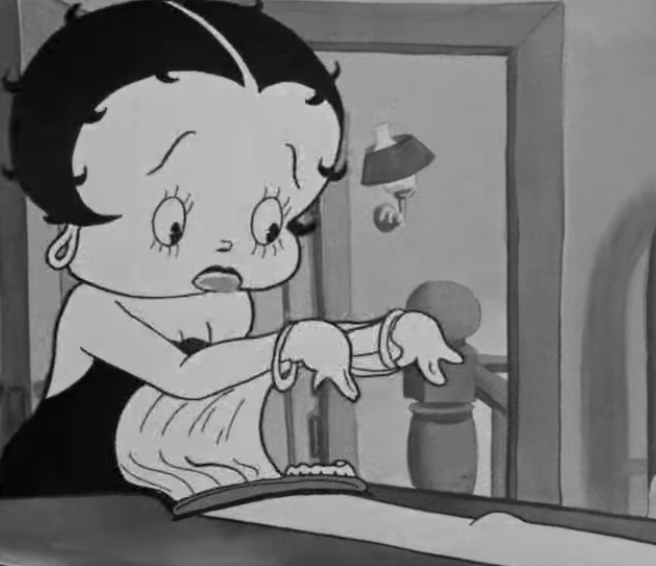
Another subtle joke: Betty has to run away from home and brings with her a towel containing… a toothbrush and nothing else. And she throws it away later.
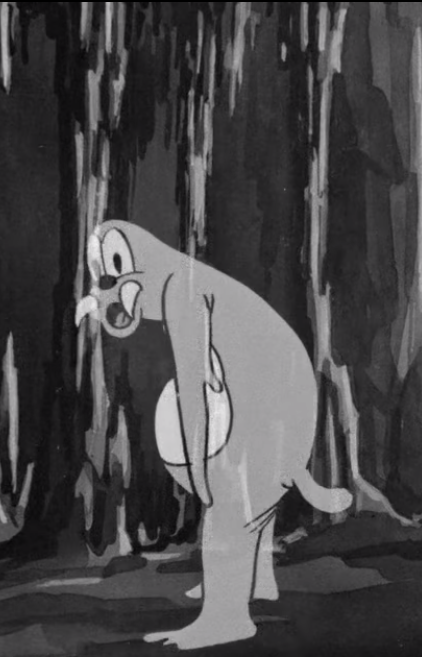
Of course the highlight is the ghost walrus dance, which is animated with rotoscoped footage of Calloway dancing. Rotoscoping often gets a bad reputation (for good reasons, too), but in this case it’s used appropriately. The rotoscoped footage this time is not just ordinary footage – it’s a dance sequence, and more importantly, a dance sequence from one of the greatest musicians of his time. Dance sequences led themselves well to animation: not only are they lively in nature (just like most animation), but they’re also “choreographed” movement, movements that’s planned ahed of time (again, exactly like animation, which will never be 100% spontaneous, but it usually involves a lot of planning). Basically, the main difference is that the rotoscope, here, is not used to achieve “realistic” movement, like in the early days, but just movement that it’s fun to watch for its own sake. It must be noted, though, that the rotoscoped walrus is not perfectly integrated with the other characters: even though it’s a lively dance number, it’s still movement produced by an actual human being, and it is in contrast with the other, more cartoony characters. This may or may not be intentional, but it actually adds to the atmosphere of the cartoon: it’s an interference of the real world in a cartoon world, and as such it appears weird (although not too much, thanks to what I’ve stated earlier). It’s probably the best short in the Talkartoons series.
The Talkartoons series ended in 1932, and was replaced with a new series dedicated entirely to Betty Boop. She was given her most iconic look, although the animation was getting stiffer and stiffer. One of the most notable shorts was I’ll Be Glad When You’re Dead You Rascal You, starring Louis Armstrong, and it’s probably one of the least coherent shorts ever put together by the Fleischers. It has, however, some interesting transitions between live-action footage (of Armstrong, of course) and animated footage that it’s worth looking at.
Snow White (1933)

This is probably my favorite Fleischer short. It contains all of the elements that made the Fleischer cartoons so great. Directed (and largely animated) by Roland Crandall, it is loosely based on the Snow White fairy tale, but it actually contains only a few key elements.
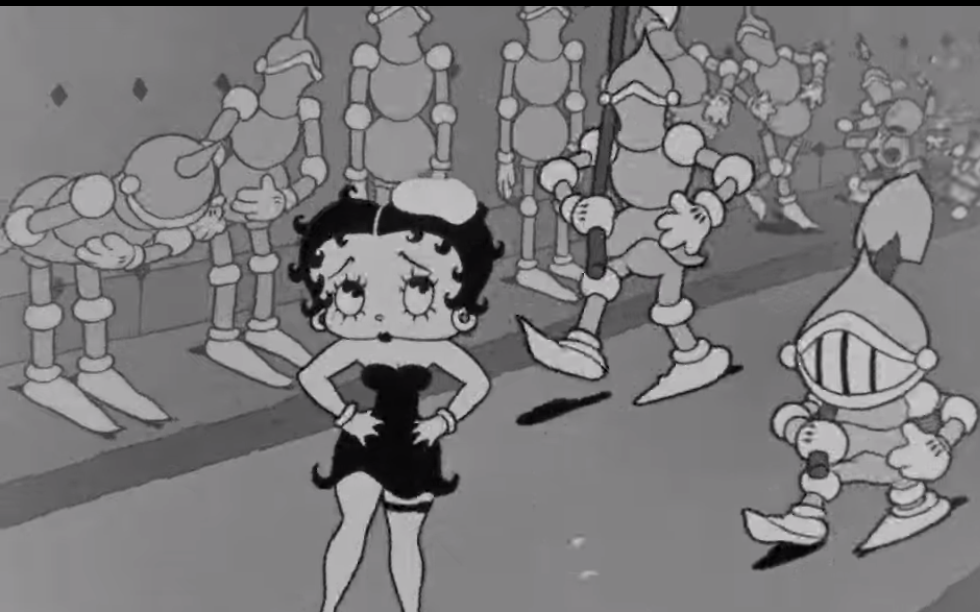
Once again, like in most Fleischer films, there’s a great number of subtle gags. In a little cycle, for example, we can see KoKo accidentally knocking down all the knights while he and Bimbo are taking Betty to see the Queen.
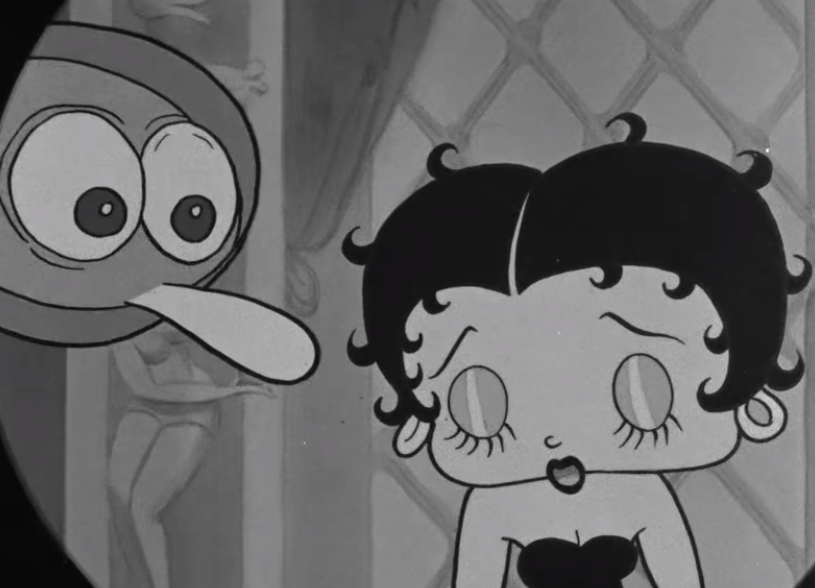
Another classic Fleischer gag was the metamorphosis of people and things. This is a classic example: the Queen’s head resembles a frying pan… and it literally turns into a frying pan.
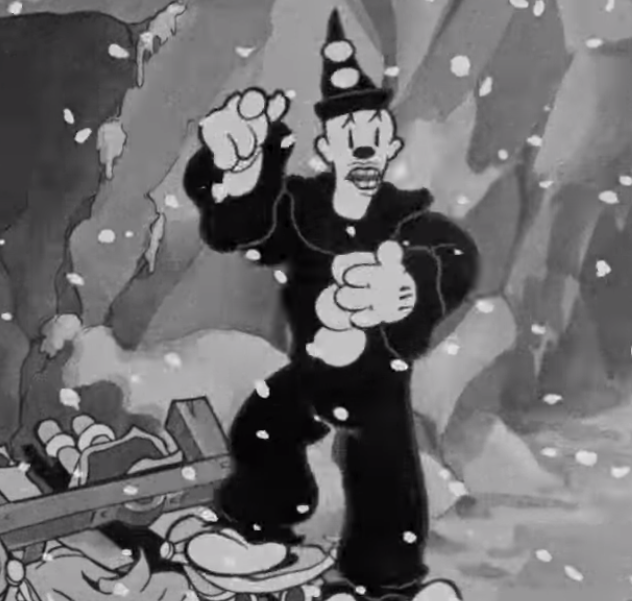
After Betty escapes from her execution, the story basically stops making sense and another classic dance scene starts.

I have already talked about the use of rotoscoping, so I won’t repeat myself here. What makes this sequence stand out, however, is how the rotoscoped and animated footage are tied together almost seamlessly. KoKo isn’t static, but he changes shape throughout the sequence: he turns into a bottle, a coin… all of this while his feet and legs are still tied to the “real world”. The blending between reality and fiction, that started with Out of the Inkwell, is finally completed here, and it’s ironic that KoKo himself is involved in this sequence.

Finally, another notable short is The Old Man of the Mountain, which is probably the peak of the mechanical Fleischer style of animation. This short is entirely musical, from beginning to end, which means all the characters are actually dancing throughout the cartoon, even if they’re simply walking. All the characters move differently, even the minor ones, and it’s a joy to watch; even the story (that it’s related to the song) makes more sense compared to other Fleischer cartoons. The rotoscope is less impressive, by contrast, but it still works.
Unfortunately, the success of Betty Boop wasn’t meant to last. The arrival of the Hays Code in 1934 and the growing popularity of the Disney shorts meant that Betty had to change, for worse: her design and personality (and, consequently, the nature of her shorts, as well) were changed for being too “risqué” for the times; even though there are still some good shorts in 1934 (the best one is probably Ha! Ha! Ha!, which almost feels like a throwback to the old KoKo cartoons) the series got worse very soon. In an attempt to (unsuccessfuly) chase the “Disney style”, the Fleischers also created a new series called Color Classics, basically their own version of the Silly Symphonies.
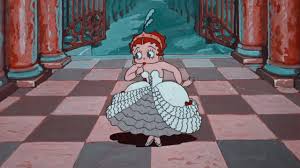
To see the downfall of quality at the Fleischer Studios between 1933 and 1934, look no further than Poor Cinderella (1934), a Color Classic starring Betty Boop. Although the short is advanced in some technical aspects, and makes a good use of the Technicolor technology, it’s as empty as it’s pretty. There’s nothing in this short that makes it truly stand out among the crowd of fairy tale adaptations and Disney imitators.
There’s no doubt that the Fleischers were the only studio that was actually able to compete with Disney, not by playing at their own game, but by changing the rules entirely. Although from what I’ve said it would seem like the end of the glory days at the Fleischer Studios (and in a sense, it is), there’s actually still one major series we need to go through… but we’ll talk about it next time.
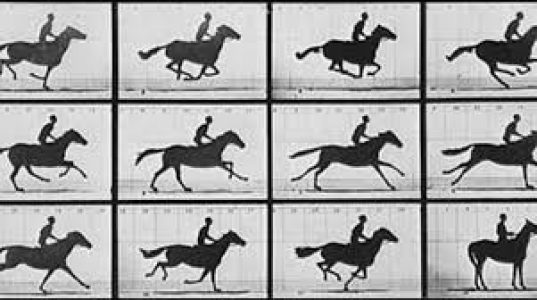
Bimbo was always one of my favorite cartoon characters. Very appealing, even with no personality.
LikeLike